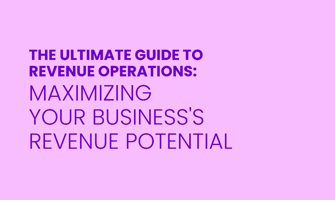Revenue operations, often referred to as RevOps, has emerged as a transformative approach that...
Creative Branding Strategies for Revenue Operations Success
A strong revenue operations strategy is important for business growth in the competitive B2B world today. This strategy includes aligning sales and marketing efforts, streamlining processes, and using data and technology.
By focusing on these areas, businesses can improve their revenue operations for better growth. In this article, we will look at each key area and offer practical tips for enhancing revenue operations strategy.
Let's discuss effective marketing strategies that can enhance Revenue Operations success and boost business growth.
Understanding Revenue Operations Success
Revops definition
Revenue operations (RevOps) is a strategic framework that brings sales, marketing, and customer success together to boost a company's revenue activities. Unlike traditional approaches, RevOps aligns these functions for a smooth transition from lead to customer. By encouraging teamwork, setting common goals, and using data-driven tactics, businesses can improve their revenue and operations.
This collaboration spans marketing strategies, sales forecasting, automation, and process simplification to drive growth. Monitoring KPIs like cost per acquisition (CPA) and customer lifetime value (CLV) is vital for tracking success and adjusting strategies for optimal revenue. With RevOps strategies, businesses can scale effectively, improve customer experiences, and achieve increased revenue and growth.
Key revops strategies
Effective integration of sales and marketing in revenue operations can be achieved by aligning teams to work toward shared goals and creating a unified customer journey.
Setting shared goals, such as lead generation targets and revenue goals, allows sales and marketing teams to collaborate effectively.
Ensuring a unified customer journey with consistent messaging and lead handoff processes can streamline operations and enhance the overall customer experience.
A focus on data and technology is crucial for enhancing revenue operations success.
Analyzing data to gain insights into sales and marketing efforts and using tools like mobile attribution data can provide valuable information for optimizing strategies.
Implementing marketing automation and CRM systems can streamline processes and provide a centralized place for managing customer data, ultimately driving growth and efficiency in revenue operations.
Streamlining processes plays a key role in optimizing revenue operations efficiency and productivity.
Implementing automation for tasks like email campaigns and lead scoring can free up time for strategic activities.
Standardizing workflows for lead generation and nurturing ensures consistency and reduces confusion, improving overall efficiency.
By streamlining processes, organizations can increase operational efficiency and drive revenue growth in a more synchronized and data-driven manner.
Branding Strategies in Revenue Operations
Integration of sales and marketing
Integrating sales and marketing can improve efficiency and increase revenue. Aligning these areas helps streamline processes, enhance customer experience, and boost revenue. It ensures both teams work together towards common goals, creating a seamless customer journey and passing leads smoothly. Collaboration between sales and marketing, with data and technology support, allows companies to make informed decisions, optimize strategies, and achieve success in revenue operations.
Leveraging data analysis and automation tools provides valuable insights, streamlines processes, and enhances operational efficiency for maximum revenue and sustained growth.
Focus on data and technology
Data and technology help businesses enhance revenue operations. They optimize processes and drive growth.
Data analysis provides insights into sales and marketing efforts. It helps identify top-performing channels and promising deals.
Understanding this data enables businesses to make informed decisions on revenue operations.
Marketing automation and CRM systems streamline processes. They automate tasks and centralize customer data management.
This integration improves efficiency, productivity, and collaboration within revenue operations.
Role of Data in Optimizing Revenue Operations
Streamlining processes
Streamlining processes in revenue operations is important for improving efficiency and productivity.
Implementing automation helps in automating repetitive tasks like email campaigns and lead scoring. This frees up time for more strategic activities.
Standardizing workflows is another effective way to streamline processes, ensuring consistency in tasks like lead generation and deal closing. This reduces confusion, improves efficiency, and eliminates bottlenecks.
Leveraging technology and data is also essential. By analyzing data, valuable insights can be gained into sales and marketing efforts, helping in making more informed decisions.
Implementing marketing and sales automation, along with CRM systems, can further streamline processes by automating tasks and managing customer data in a centralized way. This saves time and enhances operational efficiency, leading to increased revenue generation.
Efficiency and productivity
Businesses can improve revenue operations by using automation. This includes automating email campaigns, lead scoring, and parts of the sales process.
Automation helps teams focus on important tasks, boosting efficiency. Standardizing workflows for lead generation and deal closing can also help teams work together effectively.
To boost efficiency, businesses can use tools like marketing automation platforms and CRM systems. These tools automate tasks like lead routing, manage customer data, and provide insights on sales and marketing efforts.
By using these technologies, businesses can make informed decisions, streamline processes, and drive growth in revenue.
Marketing Strategies Essential for RevOps
Alignment with sales operations
Marketing strategies have a big impact on revenue operations. They work together with sales operations to boost revenue. When marketing and sales are aligned, businesses can improve processes, save time, and focus on getting leads and closing deals efficiently. This alignment results in higher sales, better customer retention, growth, and increased revenue.
Strategies like lead nurturing, content marketing, and automation help support this alignment and enhance the overall revenue operations strategy.
Outbound sales cadence is also crucial for revenue operations and sales success. It involves a structured approach to outbound sales activities. This approach ensures consistent communication with prospects, boosts conversion rates, and drives revenue growth. Outbound sales cadence helps sales teams prioritize leads, personalize outreach, and maintain steady communication to guide prospects through the sales process. This proactive approach leads to more conversions, increased revenue, and better customer relationships, making it a valuable asset in optimizing revenue operations.
Outbound sales cadence
An effective outbound sales cadence includes:
Lead nurturing: tracking interactions and providing relevant content.
Content marketing: educating customers and driving conversions.
Automation: saving time and focusing on important tasks.
The cadence fits into revenue operations by:
Streamlining processes and reducing task time.
Allowing teams to focus on strengths.
Aligning sales, marketing, and client success for a smooth transition.
To optimize the cadence:
Align teams for better coordination.
Use data-driven strategies.
Evaluate and refine processes to adapt to market changes.
Monitoring metrics like CPA and CLV is essential to measure success and maximize ROI.
Sales Techniques that Enhance Revenue Operations
Sales operations
Sales operations can be optimized to drive revenue growth:
Align sales and marketing teams
Streamline processes
Leverage data and technology
Setting shared goals, creating a unified customer journey, and implementing automation can help teams work together seamlessly.
Standardizing workflows, data analysis, and using automation tools can enhance efficiency and improve the customer experience.
Key strategies for successful revenue operations include:
Cross-departmental collaboration
Having a data-driven mindset
Continuous optimization
Monitoring metrics like cost per acquisition and customer lifetime value can measure success and maximize ROI.
Focusing on these areas can help businesses drive growth, increase productivity, and streamline revenue-generating processes for sustained success.
Successful revenue operations
Successful revenue operations require a strategic framework. This framework combines marketing, sales, and customer success under the umbrella of a RevOps framework.
This alignment is important for streamlining processes, reducing time spent on tasks, and maximizing efficiency.
By promoting collaboration and setting shared goals, organizations can drive collective action and align departmental strategies with overarching business goals.
Data-driven strategies are also important for measuring success. Metrics like Cost per Acquisition and Customer Lifetime Value provide valuable insights.
Implementing marketing strategies like lead nurturing, content marketing, and automation can help achieve successful revenue operations.
Integrating data, technology, and automation tools such as CRM systems and analytics platforms can improve operational efficiency and drive revenue generation.
Sales techniques, combined with data-driven insights and streamlined processes, are crucial for optimizing revenue operations and achieving sustainable growth.
Engaging Tools in Revenue Operations
Revenue operations software
Revenue operations software helps align sales, marketing, and customer success teams for revenue growth. It integrates functions to enhance efficiency and productivity. This software automates tasks like lead scoring and email campaigns, saving time for strategic activities. It also enables data-driven decision-making by providing insights into customer behavior and sales performance. Successful implementation leads to improved customer retention and streamlined operations.
Revops automation tools
Revops automation tools help enhance efficiency and productivity in revenue operations. These tools automate tasks like lead scoring, email campaigns, and sales processes. By doing this, they make operations smoother and give teams more time for strategic activities.
CRM systems and marketing automation platforms are examples of automation tools. They centralize data, offer insights into customer behavior, and support data-driven decision-making.
These tools optimize processes and create a more synchronized, efficient, and data-driven organization. When choosing revenue operations software, prioritize features that provide a unified view of data across sales, marketing, and customer success.
AI-enhanced software is beneficial as it captures digital buyer signals, supports complex selling motions, and can be customized to fit specific business needs.
By including these key features, businesses can improve their revenue operations strategy and boost revenue growth.
Future Trends in Revenue Operations
Opt-in for revops strategies in start-ups
Start-ups can benefit from revenue operations strategies. They can do this by aligning their sales, marketing, and customer success teams. This alignment helps in smoothly moving leads to customers. It also streamlines processes, saves time, and lets each team focus on what they do best.
Implementing lead nurturing, content marketing, and automation can help start-ups optimize their revenue operations for sustainable growth. It's important to monitor key metrics like Cost per Acquisition and Customer Lifetime Value to measure success and get the most out of investments.
Data-driven strategies and continuous optimization efforts can also boost efficiency and revenue generation for start-ups. Breaking down silos, promoting collaboration, and putting the customer first are crucial steps. These actions help create a more efficient and effective revenue operations strategy. As a result, start-ups can see increased revenue growth and success in the competitive market.
Revenue operations analysts' evolving roles
Revenue operations analysts have seen a change in their roles and responsibilities over time. Now, they take a more holistic approach to revenue generation. This means integrating sales, marketing, and customer success into one cohesive unit. The goal is to streamline processes, reduce inefficiencies, and improve the overall customer experience.
This shift in revenue operations has made certain skills and competencies necessary for analysts. They now need a strong grasp of data and technology, proficiency in automation tools, and the ability to analyze complex data sets. Analysts must use data-driven insights to boost growth, optimize processes, and make strategic decisions based on information.
As technology and data analysis progress, revenue operations analysts are adapting by using automation tools, CRM systems, and analytics platforms to make processes more efficient. By leveraging data and technology, analysts can gather insights into sales and marketing efforts, enhance the customer journey, and increase revenue for the organization.
FAQ
What are some creative branding strategies that can lead to revenue operations success?
Some creative branding strategies for revenue operations success include creating a strong brand story, leveraging user-generated content, and utilizing experiential marketing events. For example, hosting interactive workshops and pop-up shops can help engage customers and drive sales.
How important is branding in driving revenue for a company?
Branding is crucial for driving revenue as it creates customer loyalty and trust, leading to repeat purchases and referrals. Strong branding can also command premium pricing, increase market share, and open up new business opportunities.
What are some key elements to consider when developing a branding strategy for revenue operations?
Key elements to consider when developing a branding strategy for revenue operations include identifying target customers, defining value propositions, creating consistent messaging, and aligning sales and marketing efforts. Conduct market research to understand customer needs and preferences, and utilize data and analytics to track performance.
How can branding help differentiate a company from its competitors and increase revenue?
Branding helps differentiate a company by creating a unique identity, building customer trust, and showcasing value. This can lead to increased customer loyalty, higher prices, and overall revenue growth. Examples include Apple's sleek design or Nike's focus on athletic performance.
What role does storytelling play in branding strategies for revenue operations success?
Storytelling plays a crucial role in branding strategies for revenue operations success by creating emotional connections with customers, showcasing the company's values, and differentiating it from competitors. For example, sharing customer success stories can demonstrate the benefits of using a product or service.




